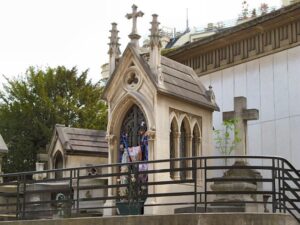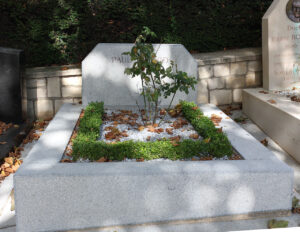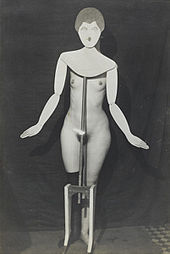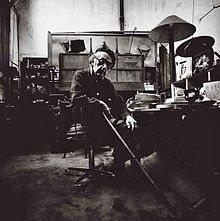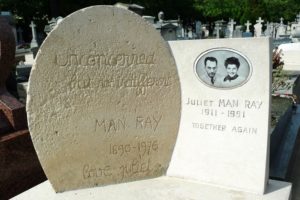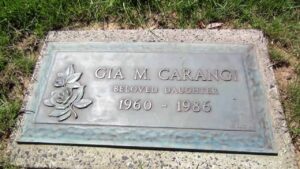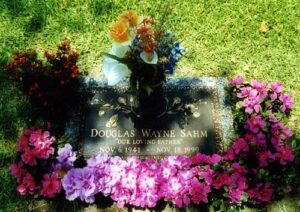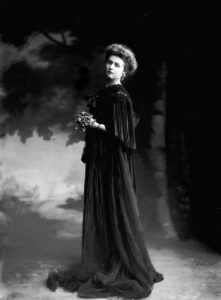 On this day in 1909 poet (Cendres et Poussières, La Vénus des aveugles, A l’heure des mains jointes, Flambeaux éteints, Sillages, Poèmes en Prose, Dans un coin de violettes, Haillons), “Muse of the Violets”, who wrote in French, in the style of the Symbolistes and the Parnassiens, Renée Vivien died in Paris from pneumonia, aged 32. Born Pauline Mary Tarn in London on 11 June 1877.
On this day in 1909 poet (Cendres et Poussières, La Vénus des aveugles, A l’heure des mains jointes, Flambeaux éteints, Sillages, Poèmes en Prose, Dans un coin de violettes, Haillons), “Muse of the Violets”, who wrote in French, in the style of the Symbolistes and the Parnassiens, Renée Vivien died in Paris from pneumonia, aged 32. Born Pauline Mary Tarn in London on 11 June 1877.
A high-profile lesbian in the Paris of the Belle Époque, she is notable for her work, which has received more attention following revival of interest in Sapphic verse. Many of her poems are autobiographical, pertaining mostly to Baudelarian themes of extreme romanticism and frequent despair. Apart from poetry, she wrote several works of prose, including L’Etre Double (inspired by Coleridge’s Christabel), and an unfinished biography of Anne Boleyn, which was published posthumously. She has been the object of multiple biographies, most notably by Jean-Paul Goujon, André Germain, and Yves-Gerard Le Dantec.
Above all, Vivien romanticized death. While visiting London in 1908, deeply despondent, she tried to kill herself by drinking an excess of laudanum. She stretched out on her divan with a bouquet of violets held over her heart. The suicide failed, but while in England, she contracted pleurisy; later, upon her return to Paris, she grew considerably weaker. According to biographer Jean-Paul Goujon, Vivien suffered from chronic gastritis, due to years of chloral hydrate and alcohol abuse. She had also started to refuse to eat. By the summer of 1909, she walked with a cane.
The cause of death was reported at the time as “lung congestion”, but likely resulted from pneumonia complicated by alcoholism, drug abuse, and anorexia nervosa. She was interred at Passy Cemetery in the same exclusive Parisian neighbourhood where she had lived.
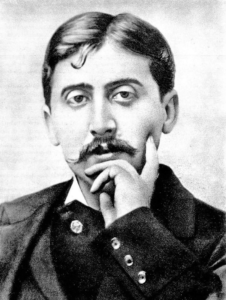 On this day in 1922, novelist Marcel Proust, died in Paris at the age of 51. Born Valentin Louis Georges Eugène Marcel Proust on 10 July 1871 in Auteuil, France. Author of the monumental À la recherche du temps perdu (In Search of Lost Time; earlier translated as Remembrance of Things Past). It was published in seven parts totaling about 3200 pages between 1913 and 1927. W. Somerset Maugham called the novel the “greatest fiction to date”. Graham Greene called Proust the “greatest novelist of the 20th century”.
On this day in 1922, novelist Marcel Proust, died in Paris at the age of 51. Born Valentin Louis Georges Eugène Marcel Proust on 10 July 1871 in Auteuil, France. Author of the monumental À la recherche du temps perdu (In Search of Lost Time; earlier translated as Remembrance of Things Past). It was published in seven parts totaling about 3200 pages between 1913 and 1927. W. Somerset Maugham called the novel the “greatest fiction to date”. Graham Greene called Proust the “greatest novelist of the 20th century”.
 The Final Footprint – Proust is entombed in an individual above ground crypt in the Père Lachaise Cemetery in Paris. Père Lachaise is the largest cemetery in Paris and one of the most visited cemeteries in the world. Other notable Final Footprints at Père Lachaise include; Guillaume Apollinaire, Honoré de Balzac, Georges Bizet, Jean-Dominique Bauby, Maria Callas, Chopin, Colette, Auguste Comte, Jean-Baptiste-Camille Corot, Ma Ernst, Molière, Jim Morrison, Édith Piaf, Camille Pissarro, Sully Prudhomme, Gioachino Rossini, Georges-Pierre Seurat, Simone Signoret, Gertrude Stein, Dorothea Tanning, Alice B. Toklas, Oscar Wilde, and Richard Wright.
The Final Footprint – Proust is entombed in an individual above ground crypt in the Père Lachaise Cemetery in Paris. Père Lachaise is the largest cemetery in Paris and one of the most visited cemeteries in the world. Other notable Final Footprints at Père Lachaise include; Guillaume Apollinaire, Honoré de Balzac, Georges Bizet, Jean-Dominique Bauby, Maria Callas, Chopin, Colette, Auguste Comte, Jean-Baptiste-Camille Corot, Ma Ernst, Molière, Jim Morrison, Édith Piaf, Camille Pissarro, Sully Prudhomme, Gioachino Rossini, Georges-Pierre Seurat, Simone Signoret, Gertrude Stein, Dorothea Tanning, Alice B. Toklas, Oscar Wilde, and Richard Wright.
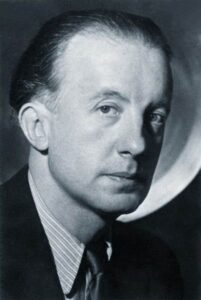 On this day in 1952 poet (Capitale de la douleur, L’Amour la Poésie, “Liberté”) a founder of the Surrealist movement Paul Éluard died from a heart attack at his home, in Charenton-le-Pont, Paris, aged 56. Born Eugène Émile Paul Grindel in Saint-Denis, Seine-Saint-Denis on 14 December 1895.
On this day in 1952 poet (Capitale de la douleur, L’Amour la Poésie, “Liberté”) a founder of the Surrealist movement Paul Éluard died from a heart attack at his home, in Charenton-le-Pont, Paris, aged 56. Born Eugène Émile Paul Grindel in Saint-Denis, Seine-Saint-Denis on 14 December 1895.
In 1916, he chose the name Paul Éluard, a matronymic borrowed from his maternal grandmother. He adhered to Dadaism and became one of the pillars of Surrealism by opening the way to artistic action politically committed to the Communist Party.
During World War II, he was the author of several poems against Nazism that circulated clandestinely. He became known worldwide as The Poet of Freedom and in my opinion, is the most gifted of French surrealist poets.
His funeral was held in the Père Lachaise Cemetery and organized by the French Communist Party. The French government refused to organise a national funeral for political reasons. A crowd of thousands spontaneously gathered in the streets of Paris to accompany Éluard’s casket to the cemetery. That day, Robert Sabatier wrote: “the whole world was mourning”.
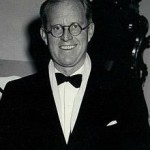 On this day in 1969, American businessman, investor, and government official, patriarch of the Kennedy Family, Joseph Kennedy died in Hyannis Port, Massachusetts at the age of 81. Born Joseph Patrick Kennedy on 6 September 1888 in Boston. He was the father of U.S. President John F. Kennedy, United States Attorney General and Senator Robert F. Kennedy, United States Senator Edward M. Kennedy, naval officer Joseph P. Kennedy, Jr., Special Olympics co-founder Eunice Kennedy Shriver, and former U.S. Ambassador to Ireland Jean Kennedy Smith. He was a leading member of the Democratic Party and of the Irish Catholic community. Kennedy was the inaugural Chairman of the U.S. Securities and Exchange Commission (SEC), appointed by President Franklin D. Roosevelt (FDR), and later directed the Maritime Commission. Kennedy served as the United States Ambassador to the United Kingdom from 1938 until late 1940, including the early part of World War II. Kennedy was educated at Harvard University, and embarked on a career in finance, making a large fortune as a stock market and commodity investor and by investing in real estate and a wide range of industries. During World War I, he was an assistant general manager of a Boston area Bethlehem Steel shipyard, through which he developed a friendship with FDR, then Assistant Secretary of the Navy. In the 1920s Kennedy made huge profits from reorganizing and refinancing several Hollywood studios, ultimately merging several acquisitions into Radio-Keith-Orpheum (RKO) studios. After Prohibition ended in 1933, Kennedy consolidated an even larger fortune when he traveled to Scotland with FDR’s son, James Roosevelt, to buy distribution rights for Scotch whisky. His company, Somerset Importers, became the exclusive American agent for Gordon’s Gin and Dewar’s Scotch. He owned the largest office building in the country at that time, Chicago’s Merchandise Mart, giving his family an important base in that city and an alliance with the Irish-American political leadership there. His term as ambassador and his political ambitions ended abruptly during the Battle of Britain in November 1940, with the publishing of his controversial remarks suggesting that “Democracy is finished in England. It may be here, [in the US].” Kennedy resigned under pressure shortly afterwards. In later years, Kennedy worked behind the scenes to continue building the financial and political fortunes of the Kennedy family. Kennedy married Rose Elizabeth Fitzgerald, the eldest daughter of Boston Mayor John Francis “Honey Fitz” Fitzgerald (political rival of his father P. J. Kennedy) and Mary Josephine “Josie” Hannon. The marriage joined two of the city’s most prominent Irish-American political families. The couple had nine children, four boys and five girls. Kennedy survived all but one of his sons and one of his daughters.
On this day in 1969, American businessman, investor, and government official, patriarch of the Kennedy Family, Joseph Kennedy died in Hyannis Port, Massachusetts at the age of 81. Born Joseph Patrick Kennedy on 6 September 1888 in Boston. He was the father of U.S. President John F. Kennedy, United States Attorney General and Senator Robert F. Kennedy, United States Senator Edward M. Kennedy, naval officer Joseph P. Kennedy, Jr., Special Olympics co-founder Eunice Kennedy Shriver, and former U.S. Ambassador to Ireland Jean Kennedy Smith. He was a leading member of the Democratic Party and of the Irish Catholic community. Kennedy was the inaugural Chairman of the U.S. Securities and Exchange Commission (SEC), appointed by President Franklin D. Roosevelt (FDR), and later directed the Maritime Commission. Kennedy served as the United States Ambassador to the United Kingdom from 1938 until late 1940, including the early part of World War II. Kennedy was educated at Harvard University, and embarked on a career in finance, making a large fortune as a stock market and commodity investor and by investing in real estate and a wide range of industries. During World War I, he was an assistant general manager of a Boston area Bethlehem Steel shipyard, through which he developed a friendship with FDR, then Assistant Secretary of the Navy. In the 1920s Kennedy made huge profits from reorganizing and refinancing several Hollywood studios, ultimately merging several acquisitions into Radio-Keith-Orpheum (RKO) studios. After Prohibition ended in 1933, Kennedy consolidated an even larger fortune when he traveled to Scotland with FDR’s son, James Roosevelt, to buy distribution rights for Scotch whisky. His company, Somerset Importers, became the exclusive American agent for Gordon’s Gin and Dewar’s Scotch. He owned the largest office building in the country at that time, Chicago’s Merchandise Mart, giving his family an important base in that city and an alliance with the Irish-American political leadership there. His term as ambassador and his political ambitions ended abruptly during the Battle of Britain in November 1940, with the publishing of his controversial remarks suggesting that “Democracy is finished in England. It may be here, [in the US].” Kennedy resigned under pressure shortly afterwards. In later years, Kennedy worked behind the scenes to continue building the financial and political fortunes of the Kennedy family. Kennedy married Rose Elizabeth Fitzgerald, the eldest daughter of Boston Mayor John Francis “Honey Fitz” Fitzgerald (political rival of his father P. J. Kennedy) and Mary Josephine “Josie” Hannon. The marriage joined two of the city’s most prominent Irish-American political families. The couple had nine children, four boys and five girls. Kennedy survived all but one of his sons and one of his daughters.
The Final Footprint – Kennedy is interred in the Kennedy private family estate in Holyhood Cemetery in Brookline, Massachusetts.
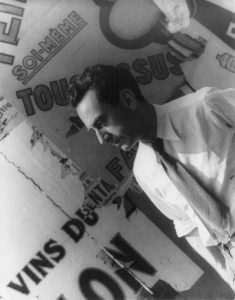 On this day in 1976, visual artist, Man Ray died in Paris from a lung infection at the age of 86. Born Emmanuel Radnitzky on August 27, 1890 in Philadelphia. He spent most of his career in Paris. He was a significant contributor to the Dada and Surrealist movements. He produced major works in a variety of media but considered himself a painter above all. Perhaps best known for his fashion and portrait photography. Man Ray is also noted for his work with photograms, which he called “rayographs” in reference to himself.
On this day in 1976, visual artist, Man Ray died in Paris from a lung infection at the age of 86. Born Emmanuel Radnitzky on August 27, 1890 in Philadelphia. He spent most of his career in Paris. He was a significant contributor to the Dada and Surrealist movements. He produced major works in a variety of media but considered himself a painter above all. Perhaps best known for his fashion and portrait photography. Man Ray is also noted for his work with photograms, which he called “rayographs” in reference to himself.
In 1913, Man Ray met his first wife, the Belgian poet Adon Lacroix (Donna Lecoeur) (1887–1975), in New York. They married in 1914, separated in 1919, and formally divorced in 1937.
In July 1921, Man Ray went to live and work in Paris, France. He soon settled in the Montparnasse quarter favored by many artists. Shortly after arriving in Paris, he met and fell in love with Kiki de Montparnasse (Alice Prin), an artists’ model and celebrated character in Paris bohemian circles. Kiki was Man Ray’s companion for most of the 1920s. She became the subject of some of his most famous photographic images and starred in his experimental films, Le Retour à la Raison and L’Étoile de mer. In 1929, he began a love affair with the Surrealist photographer Lee Miller. Miller left him in 1932.
Man Ray was in a relationship with the model Adrienne Fidelin during some time between 1936 and 1940, the two parting ways after Ray fled the Nazi occupation in France, while Adrienne chose to stay behind to care for her family.
Man Ray was forced to return from Paris to the United States due to the Second World War. He lived in Los Angeles from 1940 to 1951 where he focused his creative energy on painting. A few days after arriving in Los Angeles, Man Ray met Juliet Browner, a first-generation American of Romanian-Jewish lineage. She was a trained dancer, who studied dance with Martha Graham, and an experienced artists’ model. The two married in 1946 in a double wedding with their friends Max Ernst and Dorothea Tanning.
Man Ray returned to Paris in 1951, and settled with Juliet into a studio at 2 bis rue Ferou near the Luxembourg Gardens in St. Germain des Pres, where he continued his creative practice across mediums.
In 1963, he published his autobiography, Self-Portrait, which was republished in 1999.

1919, Seguidilla, airbrushed gouache, pen & ink, pencil, and colored pencil on paperboard, 55.8 × 70.6 cm, Hirshhorn Museum and Sculpture Garden, Smithsonian Institution, Washington, D.C.

1920, Three Heads (Joseph Stella and Marcel Duchamp, painting bust portrait of Man Ray above Duchamp), gelatin silver print, 20.7 x 15.7 cm, Museum of Modern Art, New York
The Final Footprint
He was interred in the Cimetière du Montparnasse in Paris. Ray’s epitaph reads “unconcerned, but not indifferent”. When Juliet Browner died in 1991, she was interred in the same tomb. Her epitaph reads “together again”. Juliet organized a trust for his work and donated much of his work to museums. Her plans to restore the studio as a public museum proved too expensive; such was the structure’s disrepair. Most of the contents were stored at the Pompidou Center. Other notable Final Footprints at Montparnasse include; Charles Baudelaire, Samuel Beckett, Simone de Beauvoir, Emmanuel Chabrier, César Franck, Guy de Maupassant, Adah Isaacs Menken, Man Ray, Camille Saint-Saëns, Jean-Paul Sartre, Jean Seberg, and Susan Sontag.
 On this day in 1986 supermodel Gia Carangi died of AIDS-related complications at Hahnemann University Hospital, Philadelphia, aged 26. Born Gia Marie Carangi in January 29, 1960 in Philadelphia.
On this day in 1986 supermodel Gia Carangi died of AIDS-related complications at Hahnemann University Hospital, Philadelphia, aged 26. Born Gia Marie Carangi in January 29, 1960 in Philadelphia.
Considered by many to be the first supermodel. She was featured on the cover of many magazines, including multiple editions of Vogue and Cosmopolitan, and appeared in advertising campaigns for luxury fashion houses such as Armani, Dior, Versace and Yves Saint Laurent.
After Carangi became addicted to heroin, her career rapidly declined. As she had spent most of her modeling earnings on drugs, Carangi spent the final three years of her life with various lovers, friends, and family members in Philadelphia and Atlantic City. She was admitted to an intense drug treatment program at Eagleville Hospital in December 1984. After treatment, she got a job in a clothing store, which she eventually quit. She later found employment as a checkout clerk and then worked in the cafeteria of a nursing home. By late 1985, she had begun using drugs again and was engaging in sex work in Atlantic City. Her life was dramatized in the 1998 HBO television film, Gia directed by Michael Cristofer and starring Angelina Jolie as Carangi.
In December 1985, Carangi was admitted to Warminster General Hospital in Warminster, Pennsylvania, with bilateral pneumonia. A few days later, she was diagnosed with AIDS-related complex. In the fall of 1986, Carangi was hospitalized again after being found on the street badly beaten and raped. On October 18, she was admitted to Hahnemann University Hospital. Carangi died becoming one of the first famous women to die of the disease. Her funeral was held on November 23 at a small funeral home in Philadelphia. No one from the fashion world attended. However, weeks later, Francesco Scavullo, Carangi’s friend and confidant, sent a Mass card when he heard the news. Sunset Memorial Park, Feasterville, Pennsylvania.
Carangi is often considered to be the first supermodel, although that title has been applied to others, including Margaux Hemingway, Audrey Munson, Lisa Fonssagrives, Dorian Leigh, Twiggy, Jean Shrimpton, and Janice Dickinson. Model Cindy Crawford, who rose to prominence the year Carangi died, was referred to as “Baby Gia” because of her resemblance to Carangi. Crawford later recalled, “My agents took me to all the photographers who liked Gia: Albert Watson, Francesco Scavullo, Bill King. Everyone loved her look so much that they gladly saw me.” Additionally, Carangi, whose sexual orientation has been reported as either lesbian or bisexual, is considered a lesbian icon and is said to have “epitomized lesbian chic more than a decade before the term was coined.” Argentine model Mica Argañaraz has often been compared to Carangi, whom she considers a beauty icon.
Carangi’s life has been the subject of several works. A biography of Carangi by Stephen Fried titled Thing of Beauty—taken from the first line of John Keats’ famous poem Endymion—was published in 1993. Gia, a biographical television film starring Angelina Jolie, debuted on HBO in 1998. Jolie won a Golden Globe Award and a Screen Actors Guild Award for her performance, among other accolades. A documentary titled The Self-Destruction of Gia, released in 2003, showcased footage of Carangi, contemporary interviews with Carangi’s family and former colleagues, including Sandy Linter, and footage of actress-screenwriter Zoë Lund, herself a heroin addict, who had been commissioned to write a screenplay based upon Carangi’s life at the time of her own death of drug-related causes in 1999.
A biography of Carangi by Sacha Lanvin Baumann titled Born This Way: Friends, Colleagues, and Coworkers Recall Gia Carangi, the Supermodel Who Defined an Era, was published in 2015. Sondra Scerca, who brought Carangi to Wilhelmina, is currently writing a memoir titled GIA, WILLY and ME, which will be released in 2022. The AIDS Memorial Quilt contains one panel with Carangi’s full name on it that only commemorates her, one panel that refers to her as Gia that only commemorates her, and one panel that refers to her as Gia and commemorates other people as well as her.
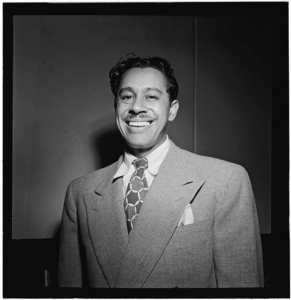 On this day in 1994, jazz singer, dancer, bandleader and actor Cab Calloway died from pneumonia in a nursing home in Hockessin, Delaware, at the age of 86. Born Cabell Calloway III on December 25, 1907 in Rochester, New York. He was associated with the Cotton Club in Harlem, New York City, where he was a regular performer and became a popular vocalist of the swing era. His niche of mixing jazz and vaudeville won him acclaim during a career that spanned over 65 years.
On this day in 1994, jazz singer, dancer, bandleader and actor Cab Calloway died from pneumonia in a nursing home in Hockessin, Delaware, at the age of 86. Born Cabell Calloway III on December 25, 1907 in Rochester, New York. He was associated with the Cotton Club in Harlem, New York City, where he was a regular performer and became a popular vocalist of the swing era. His niche of mixing jazz and vaudeville won him acclaim during a career that spanned over 65 years.
Calloway was a master of energetic scat singing and led one of the United States’ most popular big bands from the early 1930s to the late 1940s. His band included trumpeters Dizzy Gillespie, Jonah Jones, and Adolphus “Doc” Cheatham, saxophonists Ben Webster and Leon “Chu” Berry, guitarist Danny Barker, bassist Milt Hinton, and drummer Cozy Cole.
Calloway had several hit records in the 1930s and 1940s, becoming known as the “Hi-de-ho” man of jazz for his most recognized song, “Minnie the Moocher”, originally recorded in 1931. He reached the Billboard charts in five consecutive decades (1930s–1970s). Calloway also made several stage, film, and television appearances until his death in 1994 at the age of 86. He had roles in Stormy Weather (1943), Porgy and Bess (1953), The Cincinnati Kid (1965), and Hello Dolly! (1967). His career saw renewed interest in 1980 when he appeared in The Blues Brothers.
Calloway was the first African-American musician to sell a million records from a single song and to have a nationally syndicated radio show. In 1993, Calloway received the National Medal of Arts from the United States Congress.
Calloway married his first wife Wenonah “Betty” Conacher in July 1928. They divorced in 1949. Calloway married Zulme “Nuffie” MacNeal on October 7, 1949.
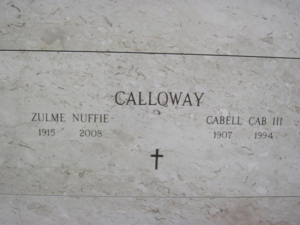 The Final Footprint
The Final Footprint
Calloway is entombed in Ferncliff Cemetery and Mausoleum in Hartsdale, New York. Other notable Final Footprints at Ferncliff include: Aaliyah, James Baldwin, Joan Crawford, Jerome Kern, Thelonious Monk, Oscar Hammerstein II, and Ed Sullivan.
He posthumously received the Grammy Lifetime Achievement Award in 2008. His song “Minnie the Moocher” was inducted into the Grammy Hall of Fame in 1999 and added to the Library of Congress’ National Recording Registry in 2019. He is also inducted into the Big Band and Jazz Hall of Fame and the International Jazz Hall of Fame.
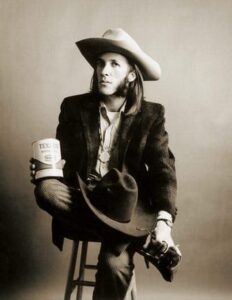 On this day in 1999, musician, singer-songwriter and multi-instrumentalist Doug Sahm died from a heart attack in Taos, New Mexico, aged 58. Born Douglas Wayne Sahm in San Antonio, Texas on 6 November 1949.
On this day in 1999, musician, singer-songwriter and multi-instrumentalist Doug Sahm died from a heart attack in Taos, New Mexico, aged 58. Born Douglas Wayne Sahm in San Antonio, Texas on 6 November 1949.
Sahm is regarded as one of the main figures of Tex-Mex music, and as an important performer of Texan Music. He gained fame along with his band, the Sir Douglas Quintet, with a top-twenty hit in the United States and the United Kingdom with “She’s About a Mover” (1965). Sahm was influenced by the San Antonio music scene that included conjunto and blues, and later by the hippie scene of San Francisco. With his blend of music, he found success performing in Austin, Texas, as the hippie counterculture soared in the 1970s.
Sahm began singing at age five and learned to play the steel guitar at age six. He was considered a child prodigy on the instrument. By the age of eight, he had appeared on the Louisiana Hayride. He made his recording debut as “Little Doug” in 1955, and was influenced by rock and roll during his teenage years. Sahm had local hit records, while he played clubs as a musician for other bands. In 1965, Huey P. Meaux produced Sahm and the Sir Douglas Quintet’s “She’s About a Mover”. The same year, Sahm moved to California. In 1971, he returned to San Antonio, and soon after he moved to Austin. Atlantic Records signed Sahm and released his debut solo album Doug Sahm and Band in 1973.
After a continuing decline in record sales, Sahm kept performing in clubs in Austin, and moved through different record labels. Meanwhile, he enjoyed success in Sweden and in Canada. In 1989, Sahm formed the supergroup the Texas Tornados with fellow Tex-Mex musicians Augie Meyers, Freddy Fender and Flaco Jiménez. The Texas Tornados toured successfully, and one of their releases earned a Grammy Award. In 1999, Sahm died during a vacation trip. A posthumous album, The Return of Wayne Douglas, was released in 2000. Sahm received multiple honors in the state of Texas, including hall of fame inductions and memorials in public places.
Sahm decided to take a vacation trip to New Mexico. He planned to visit a friend in Taos, then continue to a cabin in the Sangre de Cristo Range and finish the trip with a visit to Dan Healy in San Francisco. Sahm left for New Mexico after a brief visit with his son Shawn in Boerne, Texas. During the trip, Sahm called his son to inform him he had been feeling sick and that he often had to pull over to vomit. Sahm checked into the Kachina Lodge Hotel in Taos. His son continued calling him over the next few days. Sahm’s girlfriend, Debora Hanson, and Shawn offered to fly to New Mexico and drive him back to Texas. Sahm initially refused, but he agreed to drive himself to Albuquerque, New Mexico, to meet Hanson there for the drive back to Texas. As his condition worsened, he asked a clerk about local doctors. They advised him to visit the local emergency room, but he did not do so. Sahm was found dead in his hotel room. Local authorities determined it to be a death by natural causes, but an autopsy was ordered. The results of the autopsy determined that Sahm died of arteriosclerotic cardiovascular disease, described as a heart attack. The Austin Music Network aired a three-hour tribute to Sahm, while KUT dedicated an episode of one of its shows to his music. A memorial concert was announced to take place at Antone’s in December 1999.
On November 23, 1999, Sahm’s funeral took place at the Sunset Memorial Home in San Antonio. Loudspeakers were placed outside of the funeral home for the service to be heard by the estimated one thousand mourners in attendance. According to the Austin American Statesman, the crowd consisted of people “across all lines of age, race and social standing”. The viewing lasted an hour and a half, as the mourners passed Sahm’s casket and left keepsakes. Fender chose not to attend the funeral to avoid distracting the crowds with his presence. Sahm was buried in a private ceremony at Sunset Memorial Park in San Antonio, next to his mother and father.
In July 2000, the songs recorded at the Cherry Ridge Studios sessions the previous year were released on the posthumous album The Return of Wayne Douglas.
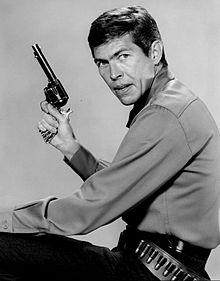 On this day in 2002, Academy Award winning actor James Coburn died of heart attack while listening to music in his Beverly Hills home at the age of 77. Born James Harrison Coburn III in Laurel, Nebraska on 31 August 1928. Coburn was featured in over 70 films and made 100 television appearances during his 45-year career, winning an Academy Award for his supporting role as Glen Whitehouse in Affliction. His rugged and “cool” persona made him a prpminent tough guy in numerous leading and supporting roles in westerns and action films, such as The Magnificent Seven (1960), The Great Escape (1963), Major Dundee (1965), Our Man Flint (1966), In Like Flint (1967), Duck, You Sucker! (1971), Pat Garrett and Billy the Kid (1973), Charade (1963) and Cross of Iron (1977). Coburn married twice; Beverly Kelly (1959 – 1979 divorce) and Paula Murad (1993 – 2002 his death).
On this day in 2002, Academy Award winning actor James Coburn died of heart attack while listening to music in his Beverly Hills home at the age of 77. Born James Harrison Coburn III in Laurel, Nebraska on 31 August 1928. Coburn was featured in over 70 films and made 100 television appearances during his 45-year career, winning an Academy Award for his supporting role as Glen Whitehouse in Affliction. His rugged and “cool” persona made him a prpminent tough guy in numerous leading and supporting roles in westerns and action films, such as The Magnificent Seven (1960), The Great Escape (1963), Major Dundee (1965), Our Man Flint (1966), In Like Flint (1967), Duck, You Sucker! (1971), Pat Garrett and Billy the Kid (1973), Charade (1963) and Cross of Iron (1977). Coburn married twice; Beverly Kelly (1959 – 1979 divorce) and Paula Murad (1993 – 2002 his death).
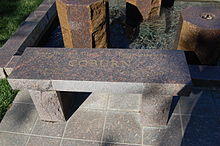 The Final Footprint – Coburn was cremated and his cremains were inurned in Westwood Village Memorial Park Cemetery (a Dignity Memorial® provider) in Los Angeles, California, and marked by a stone bench inscribed with his name. Other notable final footprints at Westwood include; Ray Bradbury, Sammy Cahn, Truman Capote, Rodney Dangerfield, Farrah Fawcett, Brian Keith, Don Knotts, Hugh Hefner, Burt Lancaster, Peter Lawford, Peggy Lee, Janet Leigh, Jack Lemmon, Karl Malden, Dean Martin, Walter Matthau, Marilyn Monroe, Carroll O’Connor, Roy Orbison, George C. Scott, Dorothy Stratten, Natalie Wood, and Frank Zappa.
The Final Footprint – Coburn was cremated and his cremains were inurned in Westwood Village Memorial Park Cemetery (a Dignity Memorial® provider) in Los Angeles, California, and marked by a stone bench inscribed with his name. Other notable final footprints at Westwood include; Ray Bradbury, Sammy Cahn, Truman Capote, Rodney Dangerfield, Farrah Fawcett, Brian Keith, Don Knotts, Hugh Hefner, Burt Lancaster, Peter Lawford, Peggy Lee, Janet Leigh, Jack Lemmon, Karl Malden, Dean Martin, Walter Matthau, Marilyn Monroe, Carroll O’Connor, Roy Orbison, George C. Scott, Dorothy Stratten, Natalie Wood, and Frank Zappa.
Have your planned yours yet?
Follow TFF on twitter @RIPTFF

